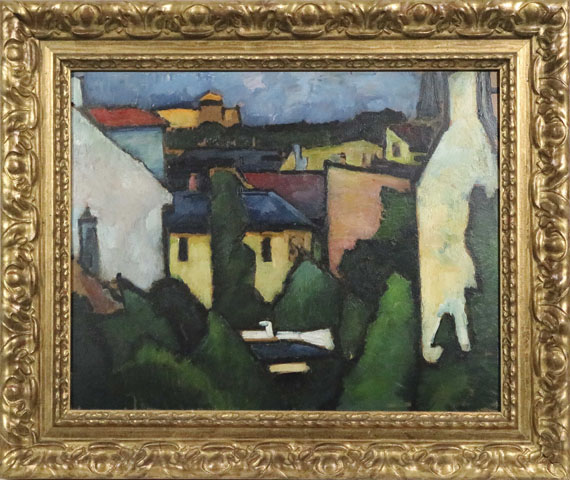238
Alexander Kanoldt
Nikolaiplatz, 1910/1913.
Oil on cardboard
Estimate:
€ 60,000 / $ 67,800 Sold:
€ 93,750 / $ 105,937 (incl. surcharge)
Nikolaiplatz. 1910/1913.
Oil on cardboard.
36.8 x 46 cm (14.4 x 18.1 in).
For the motif cf. the paintings "Häuser im Grünen, Nikolaiplatz" from 1910 and "Nikolaiplatz Schwabing" from 1913 (Koch 12 and 21).
The work will be included into the forthcoming catalog raisonné compiled by Dr. Michael Koch, Munich.
PROVENANCE: Dr. Walter Riezler, director of 'Städtisches Museum Stettin' (obtained directly from the artist).
Private collection (inherited).
Private collection USA (directly from aforementioned).
Oil on cardboard.
36.8 x 46 cm (14.4 x 18.1 in).
For the motif cf. the paintings "Häuser im Grünen, Nikolaiplatz" from 1910 and "Nikolaiplatz Schwabing" from 1913 (Koch 12 and 21).
The work will be included into the forthcoming catalog raisonné compiled by Dr. Michael Koch, Munich.
PROVENANCE: Dr. Walter Riezler, director of 'Städtisches Museum Stettin' (obtained directly from the artist).
Private collection (inherited).
Private collection USA (directly from aforementioned).
In the years 1910/11 Alexander Kanoldt lived on ‘Nikolaiplatz’ in Munich/Schwabing. The view from the window of his studio over the rooftops of Schwabing, formerly a village that had become part of the city, is a typical document from a time of stylistic transition that Alexander Kanoldt’spaiting underwent in those days. From plein-air painting under the influence of academy teachings over attempts in Divisionism, Kanoldt found his artistic path in the consolidating forms, a path he would follow and refine until the end of his life. Kanoldt had major influence on the development of New Objectivity, for which the transition period around 1910/11 played a key role. As member of the "Neuen Künstlervereinigung München", from which the "Blaue Reiter" emerged, Kanoldt followed a route that led him to his very own concept of color and forms under the impressions of the exchange with his artist colleagues, especially with Jawlensky. The fact that Kanoldt left all academic influence behind becomes particularly obvious in the primary color application on the unprimed cardboard of this work. His preference for pure surface colors for the pictorial elements also indicates the unorthodox style that Kanoldt had attained by these important days around 1910/11.
238
Alexander Kanoldt
Nikolaiplatz, 1910/1913.
Oil on cardboard
Estimate:
€ 60,000 / $ 67,800 Sold:
€ 93,750 / $ 105,937 (incl. surcharge)
Headquarters
Joseph-Wild-Str. 18
81829 Munich
Phone: +49 89 55 244-0
Fax: +49 89 55 244-177
info@kettererkunst.de
Louisa von Saucken / Christoph Calaminus
Holstenwall 5
20355 Hamburg
Phone: +49 40 37 49 61-0
Fax: +49 40 37 49 61-66
infohamburg@kettererkunst.de
Dr. Simone Wiechers / Nane Schlage
Fasanenstr. 70
10719 Berlin
Phone: +49 30 88 67 53-63
Fax: +49 30 88 67 56-43
infoberlin@kettererkunst.de
Cordula Lichtenberg
Gertrudenstraße 24-28
50667 Cologne
Phone: +49 221 510 908-15
infokoeln@kettererkunst.de
Hessen
Rhineland-Palatinate
Miriam Heß
Phone: +49 62 21 58 80-038
Fax: +49 62 21 58 80-595
infoheidelberg@kettererkunst.de
We will inform you in time.




 Lot 238
Lot 238 

